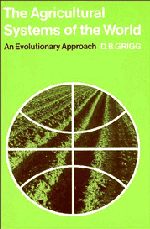Book contents
- Frontmatter
- Contents
- Acknowledgements
- 1 Introduction
- PART ONE
- PART TWO
- 5 Shifting agriculture
- 6 Wet-rice cultivation in Asia
- 7 Pastoral nomadism
- 8 Mediterranean agriculture
- 9 Mixed farming in western Europe and North America
- 10 Dairying
- 11 Plantations
- 12 Ranching
- 13 Large-scale grain production
- 14 Conclusions
- Appendix: Regions of plant domestication
- Notes
- Bibliography
- Index
8 - Mediterranean agriculture
Published online by Cambridge University Press: 10 March 2010
- Frontmatter
- Contents
- Acknowledgements
- 1 Introduction
- PART ONE
- PART TWO
- 5 Shifting agriculture
- 6 Wet-rice cultivation in Asia
- 7 Pastoral nomadism
- 8 Mediterranean agriculture
- 9 Mixed farming in western Europe and North America
- 10 Dairying
- 11 Plantations
- 12 Ranching
- 13 Large-scale grain production
- 14 Conclusions
- Appendix: Regions of plant domestication
- Notes
- Bibliography
- Index
Summary
Mediterranean agriculture is that type found in the areas surrounding the Mediterranean Sea which have mild, wet winters and hot, dry summers, and also in those areas elsewhere with a similar climate – central and southern California, central Chile, the south west of Cape Province, the south west of Western Australia and the southern part of South Australia. In terms of area occupied, in numbers employed or in the value of its products, it is not of major importance. Nor would all writers accept it as a valid type, for within the Mediterranean basin a variety of agricultural enterprises are pursued (Fig. 17), whilst some writers are unhappy with the assumption that similar climates give rise to similar types of farming. But the agriculture of the Mediterranean has played a major role in the evolution of agriculture in the western world, and on this ground alone it justifies discussion.
Three environmental characteristics have been of fundamental importance in the evolution of traditional Mediterranean agriculture. First is the long summer drought; rainfall is confined to the winter half of the year. Unless crops are irrigated they must either be sown in the autumn and harvested by early summer, or be capable of resisting drought. Second are the comparatively mild winters and hot, sunny summers. Temperatures are such that a variety of temperate crops can be grown in the rainy season, and – with irrigation – sub-tropical crops in the summer. Thus, given adequate moisture, not only rice, sugar-cane, tobacco, citrus fruits and even bananas can be grown, but wheat, barley, potatoes and deciduous fruits as well.
- Type
- Chapter
- Information
- The Agricultural Systems of the WorldAn Evolutionary Approach, pp. 123 - 151Publisher: Cambridge University PressPrint publication year: 1974



